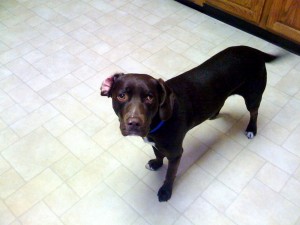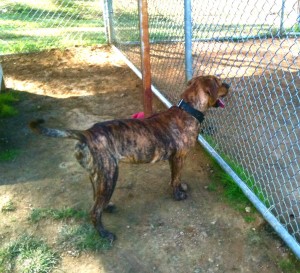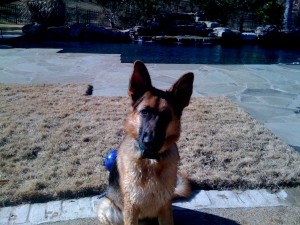 Okay, so your dog is fearful, barking, lunging and otherwise distressed when he or she sees people, trucks, cars, or dogs. Depending on who you are talking to, those behaviors may be classified as territory or protective aggression, possession aggression, inter-dog aggression, fear aggression, or leash aggression.
Okay, so your dog is fearful, barking, lunging and otherwise distressed when he or she sees people, trucks, cars, or dogs. Depending on who you are talking to, those behaviors may be classified as territory or protective aggression, possession aggression, inter-dog aggression, fear aggression, or leash aggression.
I’ll refer to the other people, other dogs, trucks, cars, as “triggers”, because they trigger the fear or aggression in your dog.
There are volumes of articles and books on how to modify fearful and aggressive behaviors in dogs. Some of the information may be helpful and other information is outdated and less helpful.
A canine modification plan is fluid. It changes as you progress. Because of all the variables, and the constant adjustments when treating fear and aggression in dogs, it’s not feasible for me to post all the methods and solutions I would use in a private consultation.
But I can give you this overview and some instructions that might work with your dog.
This article is about visual triggers. If your dog reacts to noises, the same concepts apply.
 Print This Post
Print This Post
First you need to change your dog’s perception of the triggers. Then you will use rewards to pay your dog for desirable, non reactive behaviors, when the trigger is in sight.
Before you actually do exercises with your dog in the field, please review this checklist.
Meet your dog’s physical, social and emotional needs.
Kindly prevent your dog from practicing unwanted reactive behaviors.
Establish a method to communicate precisely. Condition a reward marker.
Enact the Rewards Awareness Program.
Establish a Reward System.
Teach your dog “attention on cue” or “look”.
Practice “look” in various places with increasing levels of distractions (distractions should not be people or dogs or whatever triggers the unwanted, reactive, behaviors).
Teach your dog to sit on command.
Practice “sit” in various places with increasing levels of distractions (distractions should not be people or dogs or whatever triggers the unwanted, reactive, behaviors).
Teach your dog to bump your two-finger target to the cue, “here”.
Practice “here” in various places with increasing levels of distractions (distractions should not be people or dogs or whatever triggers the unwanted, reactive behaviors).
Teach your dog to walk nicely on a loose lead or to heel.
Practice walking nicely in various places with increasing levels of distractions (distractions should not include the triggers).
Optional: Obtain a Gentle Leader head collar or a Canny Collar. Introduce your dog to the head collar and practice with the head collar, so that your dog is not distracted by wearing the head collar. Head collars make it possible to safely move or control your dog’s pulling behaviors.
Optional: If your dog is “crazy excited” for squeaky toys or balls, get a couple of new ones and save them for these exercises. You can use the toys as rewards, or as distractions to get your dog’s attention when the triggers are too close.
Now you can begin the real work!
Identify the Threshold
Find the distance where your dog can see the trigger but not react with “out of control” barking, lunging, et cetera. I’ll refer to this distance as the threshold for reactivity. It may be 400 yards or 20 feet. It will change depending on the environment, your dog’s current emotional or physical state, or any number of factors.
The threshold is fluid, not static. You’ll need to find the threshold every time you start a practice session. Whatever it is right now, this distance or threshold will become shorter and shorter as you practice. You’ll always start each session outside the threshold.
Set up the Practice Session
For this step you’ll need the help of others. Their jobs will be to present the trigger outside the threshold, move a few steps closer and then move back outside the threshold.
If you don’t have any helpers, you can still set up the session. Go to a place where you are likely to see the triggers, such as a walking path at the park or a parking lot of a pet supply store. Get several feet off the path or away from the traffic, outside the threshold.
It helps if your dog is hungry. Do this before feeding time or withhold dinner and feed during these sessions.
Change your Dog’s Perception
Before you start with the triggers, ask your dog to perform a few simple commands such as “here’ or “sit”. This will engage your dog to pay attention to you!
Stand outside the threshold of a trigger. The instant you see the dog or person or car approaching, announce the trigger. Tell your dog something like “that’s a friend or that’s a truck” and immediately feed your dog several treats. Keep feeding until the trigger has retreated and is no longer nearby.
(If your starts barking or lunging, you are too close the the trigger, move away. If your dog starts to stare or looks like he or she might be ready to bark and lunge, command “here” and present your two finger target, or ask your dog to “look”. Either one of these commands gets the dog to look away from the trigger and focus on you.)
This sequence is called a cycle. You will hold many cycles during a session.
Between each cycle, give your dog a tension rest to absorb the recent events. The tension rest should be as as long as it took to perform the cycle. So, if the trigger is in sight for 10 seconds before it moves outside the threshold, the duration of the tension rest immediately after the cycle will be at least 10 seconds.
Repeat this process for at least 30 minutes per session. Perform another cycle followed by a tension rest. The idea is to change your dog’s immediate, involuntary responses to the trigger.
Instead of “oh no, there’s another dog, which is immediately followed by involuntary barking, fleeing, freezing or lunging (fight, flight, freeze behaviors), you want your dog’s initial involuntary response to the sight of the triggers to be anticipation of food. You are using classical conditioning to associate the trigger with the delivery of food. Your dog cannot be aggressive or fearful and salivate in anticipation of food at the same instant!
As you progress through the session, you will notice your dog will begin to ignore the trigger and focus on you and the food as soon as you announce the trigger. Perfect. Now you can move a bit closer to the trigger and continue. The threshold is getting shorter!
Repeat these sessions until your dog automatically looks towards you whenever a trigger is in sight. Continue to announce the triggers on routine walks, and anytime you are interacting with your dog, be it during a practice session, or not.
Real LIfe Ambush
If you get “ambushed” by a trigger during an outing, and you are not ready with several treats, kindly ask your dog to sit facing you, or to bump your two finger target. If she is too excited, move her away from the trigger and ask again. Repeat this sequence until your dog is far enough away that she will listen to your commands.
This basic method will work with most dogs, and most reactive behaviors, however it is not as efficient as perception modification via Syn Alia Training System.
Keep in mind, there are many factors about your relationship and your daily interactions with your dog that influence behaviors. In addition, your dog may be influenced by other dogs in the household, medical conditions, diet, nutrition, genetic and or neurological factors. If your dog constantly barks at triggers from inside the house, or fence fights with the dogs next door, the prognosis is poor.
You’ll need to prevent your dog from practicing fear and aggression if you want to succeed!
Happy Training!
Alan J Turner
How’s Bentley
Canine Behavior Modification for Fear, Aggression in Dogs – Memphis TN
New iPhone app -Dog and Puppy Shake – Fun Facts and Trainer Truths
21st Century Dogs – Dog and Puppy Club
 Join the forum discussion on this post - (1) Posts
Join the forum discussion on this post - (1) Posts
 Common submissive dog behaviors include lowering of head, tail, body, or rolling over and exposing the underside.
Common submissive dog behaviors include lowering of head, tail, body, or rolling over and exposing the underside.



